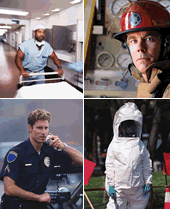Montana Oil Spill - Silvertip Pipeline Incident
NOTE: This page is archived for historical purposes and is no longer being maintained or updated.

Response Worker Safety and Health
On July 1, 2011, a break occurred in a 12-inch pipeline under the Yellowstone River, 20 miles upstream from Billings, Montana. The U.S. Environmental Protection Agency is leading the response efforts in close coordination with the state of Montana and other federal agencies. See ( http://www.epa.gov/yellowstoneriverspill/ ).
Oil spill clean-up activities can be hazardous. Workers and volunteers involved with cleanup activities should be aware of the potential dangers involved, and the proper safety precautions. Work-related hazards that could be encountered include: heat stress, cold stress, fatigue, chemical hazards, and musculoskeletal hazards. Links to information about hazards associated with cleanup activities can be found below. This information is intended to help employers and workers prepare for anticipated response activities, and to prevent work-related injuries and illnesses in the field.
Public health support on-scene currently includes local Montana’s State environmental health leadership, local response groups and ExxonMobil spill response contractors. The federal spill response leadership is being provided by the USEPA Region VIII and USCG Pacific Region response agency disaster response specialists.
Health Hazard Evaluation Program
At no cost to employers or employees, or their representatives, the NIOSH Health Hazard Evaluation (HHE) program may be able to help with problems like these. This site lets you know about the program and how to ask for NIOSH help.
Symptoms of Exposure
Workers are urged to report any symptoms they associate with their response work to their employer, physician, poison control center, state or local health department of a local health facility. As part of a comprehensive worker safety and health program there should be a system for reporting symptoms, near-misses, injuries and illnesses. These reports should be analyzed to assess real-time trends so that actions can be taken to prevent similar incidents.
Symptoms reported from excessive exposure to crude oil commonly include the following:
- eye, nose and throat irritation
- headache
- dizziness
- upset stomach
- cough or shortness of breath
Resources
Health Recommendations for Relief Workers Responding to Disasters
Provides a broad scope of information on risks and prevention strategies for relief workers.
NIOSH Emergency Response Chemical Hazards Page
Chemical agent information is needed for workers to appropriately plan for risks resulting from possible chemical incidents. Several organizations have developed information databases, including short-term and long-term criteria, each with specific purposes, exposure scenarios, and severity of adverse health effects considered in their development.
NIOSH Emergency Response Personal Protective Equipment Page
Personal protective equipment is very important for any emergency responder. There are five main types of PPE that are covered on this page: respirators and protective clothing (selection, proper use, etc.), skin exposures and eye and hearing protection.
Cold Stress
Workers who are exposed to extreme cold, work in cold environments, have prolonged contact with cold river water may be at risk of cold stress. Extreme cold exposure, including from water, is a dangerous situation that can bring on health emergencies in susceptible people.
Heat Stress
Workers who are exposed to extreme heat, work in hot environments, areas of high elevation, low humidity, or intense sun are at high risk for heat stress. Exposure to extreme heat can result in occupational illnesses and injuries. Heat stress can result in heat stroke, heat exhaustion, heat cramps, or heat rashes.
Fatigue
Disaster response workers often work longer shifts and more consecutive shifts than the typical 40-hour work week. Working longer hours may increase the risk of work injuries and accidents and can contribute to poor health. Management plans should be in place to minimize fatigue risks, recognize hazards, and provide regular opportunities for worker rest and recovery.
NIOSH Ergonomics and Musculoskeletal Disorders Topic Page
A resource of practical ways to reduce ergonomics hazards to workers.
- Page last reviewed: July 7, 2011 (archived document)
- Content source:
- National Institute for Occupational Safety and Health Office of the Director


 ShareCompartir
ShareCompartir